Birds
Media
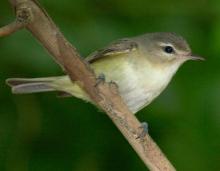
Species Types
Scientific Name
Vireo gilvus
Description
The warbling vireo is a drab little bird with a colorful, brilliant song. It’s a common summer resident. Listen for it in forests, woodlands, and suburbs, especially in large trees near water.
Media
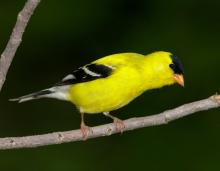
Species Types
Scientific Name
Spinus tristis
Description
Goldfinches are often seen in flocks during fall, winter, and spring and at bird feeders. In spring, the male’s dull winter plumage changes to bright yellow with a black cap and wings.
Media
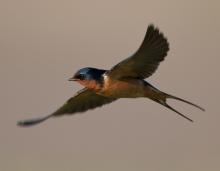
Species Types
Scientific Name
Hirundo rustica
Description
Streamlined, agile fliers with forked tails, barn swallows build cup-shaped nests out of mud affixed to protected areas on the walls of barns and under bridges.
Media

Species Types
Scientific Name
Petrechelidon pyrrhonota
Description
Cliff swallows fly in swarms around their clusters of juglike mud nests attached to overpasses, bridges, and other structures. Note the whitish forehead, buffy rump patch, and chestnut throat.
Media

Species Types
Scientific Name
Chaetura pelagica
Description
About the only way to see chimney swifts — unless you look in a chimney flue — is while they’re flying. They look like “flying cigars,” with long narrow wings, and chitter loudly as they fly.
Media
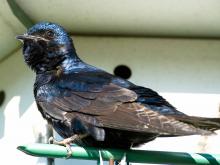
Species Types
Scientific Name
Progne subis
Description
Generations of Americans have greeted the annual return of purple martins, with their cheerful calls, graceful flight, and faithful reappearance each year. But martin populations have been declining. Find out what you can do to help these agile fliers.
Media
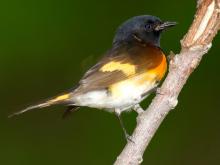
Species Types
Scientific Name
Setophaga ruticilla
Description
American redstarts flit among tree branches, drooping their wings, fanning their tails, and leaping into the air to catch insects. Males are black and orange; females are olive-gray and white.
Media

Species Types
Scientific Name
Spizella passerina
Description
A common summer resident, the chipping sparrow forages on the ground in open areas with plenty of trees, especially evergreens. Note the chestnut crown, narrow black eyeline, and gray rump.
Media
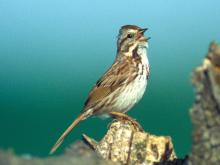
Species Types
Scientific Name
Melospiza melodia
Description
The song sparrow is an uncommon nester but a common winter resident throughout Missouri. You can find the song sparrow along forest edges and in many backyards.
Media
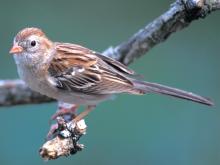
Species Types
Scientific Name
Spizella pusilla
Description
Field sparrows live in weedy, brushy fields, glades, and overgrown pastures. They have a gray head with rusty side stripes on the crown, and a rusty eyeline and cheek. The bill and legs are pink.
See Also
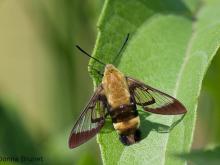




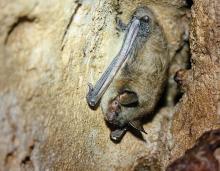
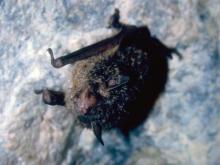
Media

Species Types
Scientific Name
Hemaris diffinis
Description
The snowberry clearwing is a moth that confuses people because it looks like a bumblebee and flies like a hummingbird!
Media

Species Types
Scientific Name
Hyles lineata
Description
The white-lined sphinx moth sometimes confuses people because it flies, hovers, and eats from flowers like a hummingbird. The adults often fly during daylight hours as well as in the night and are often found at lights.
Media

Species Types
Scientific Name
Darapsa myron
Description
The Virginia creeper sphinx moth is common in woods and brushy areas and comes to lights at night. The larvae eat Virginia creeper and grape leaves.
Media

Species Types
Scientific Name
Perimyotis subflavus (formerly Pipistrellus subflavus)
Description
Tri-colored bats, formerly called eastern pipistrelles, are relatively small and look pale yellowish or pale reddish brown. The main hairs are dark gray at the base, broadly banded with yellowish brown, and tipped with dark brown.
Media

Species Types
Scientific Name
Myotis grisescens
Description
Gray myotises are difficult to distinguish from other mouse-eared bats. A key identifying feature of the gray myotis is that its wing is attached to the ankle and not at the base of the toes. It’s an endangered species.
Media

Species Types
Scientific Name
Myotis lucifugus
Description
The little brown myotis (little brown bat) is one of our most common bats, but populations are declining. White-nose syndrome has taken a heavy toll in northeastern states. This species is now listed as vulnerable across its range.
Media

Species Types
Scientific Name
Myotis sodalis
Description
The Indiana myotis, or Indiana bat, summers along streams and rivers in north Missouri, raising its young under the bark of certain trees. It is an endangered species.
About Birds in Missouri
About 350 species of birds are likely to be seen in Missouri, though nearly 400 have been recorded within our borders. Most people know a bird when they see one — it has feathers, wings, and a bill. Birds are warm-blooded, and most species can fly. Many migrate hundreds or thousands of miles. Birds lay hard-shelled eggs (often in a nest), and the parents care for the young. Many communicate with songs and calls.





















